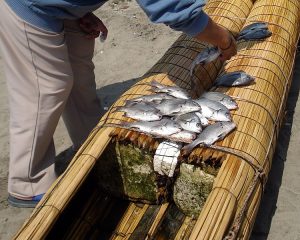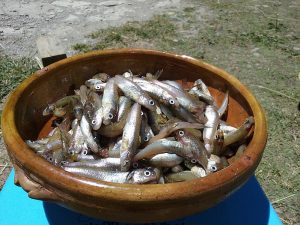Kene which means “design” in Shipibo are the visual representations of Shipibo knowledge including cultural memory, connection to the ancestral land, and healing. This knowledge represents the Shipibo cosmology such as origin stories and the human relationship between the earth such as the Ucayali River which contributes to Shipibo foodways greatly. Reading The Uros People by Valentina Gonzalez, Grace Livengood, Khushi Malhotra, and Sophia-Joe Lunny I remembered the Shipibo people and how they served both the needs of their culture and the outsider tourists. The Shipibo integrate symbols that are appealing to Western aesthetics into their kene textile design such as the ayahuasca plant or serpents. This way they are able to address Western taste and sell these textiles participating in the global market and making monetary gains. The Shipibo kene designs are different than the kene that the Shipibo see. The touristic kene design is more repetitive and does not give away the knowledge systems of the Shipibo. This allows them to preserve their knowledge systems and please the tourists serving both their needs and the others.
Uros also have a similar way of participating in the global world and serving both their needs and the tourists. Gina Lujano Suaña, a Uros woman owns a local restaurant called Suma Kurmi (beautiful rainbow) that attracts a lot of tourists. This restaurant enables a source of income for the owner’s family and the tourists to try Uros traditional food. She, however, instead of cooking and serving traditional fish such as el acarchi, el ispi, and el mauri uses trout. Trout is a more commercial fish that the tourists are more comfortable consuming than those other types of fish. Also using trout prevents resource depletion of the traditional fish in the Uros diet. This way the Uros can preserve their traditional foodways and also please the tourists by letting them taste their local recipes. As a result, the Uros do not have to be concerned with the lack of traditional fish supply due to increasing demand in the global world by the tourists just like in the case of Totoras. As the interest in eco-friendly water transportation with the use of Totoras grows in the global world the Uros are concerned with its depletion within their communities as it is a significant Uros first food. In conclusion, both Shipibo and Uros have presented viable solutions to respect their culture and keep the tourists visiting them content. Thus it seems pleasing both sides in both cases is possible creating a win-win situation.

A fishing boat made of Totora ( A Caballito) https://commons.wikimedia.org/wiki/File:Pescado_Fresco_-_caballito_totora.jpg

El ispi https://commons.wikimedia.org/wiki/File:Ispi_challwa.jpg

Hi Alara,
I really liked your reflection and the way you linked the Shipibo Konibo way of preserving their autonomy, making tourist-oriented Kene with Gina Lujano’s restaurant serving tourist-oriented traditional food. I really enjoyed looking at your other posts as well. I hope that your final week of classes is going well and that you can come to Oaxaca again anytime soon. ????
The “????” were supposed to be a happy face jajaj 🙂 not sure why emojis don’t work.
hahahaha thank you! I its so funny how we can not edit the comments it happened to me too a couple times! I agree hope to meet you in person soon as well!
Hi Alara!
Thank you for writing such an interesting post, it was really nice chatting to you in class today too! I loved the comparison you make with the Shipibo-Konibo, and how, despite keeping the purpose of their handicrafts as solely for income, they are able to put in a little more effort to make it more appealing to tourists. The Uros do indeed, have the same mindset as to ensure not only are they earning, but they are showcasing their culture to others through these handicrafts that they build. It is interesting to see that sometimes Indigenous communities can end up fighting for themselves and their rights to be able to create a win-win situation like you outlined! Glad you liked our post!
Hi Alara!
I really like the connection that you drew from the Shipibo-Konibo to the Uros, as was mentioned by Khushi and Fernanda above. I also found it really interesting that these Indigenous groups have found ways to please the tourist crowds while still retaining their sacred knowledge. I was struck throughout the original lecture post on the Uros how they seem to have maintained a lot of their autonomy, as well as all of the different positive aspects of the way they continue their traditions while incorporating globalization. I think not everyone would call it a “win-win,” as we talked about with the Shipibo-Konibo, some people may question the ‘authenticity’ of these crafts and foods since they have been altered. However, I don’t think you can ever please everyone, and this certainly creates a positive outcome for the most amount of people.
I can tell that you put a lot of thought into crafting your content, and it makes a big difference. I look forward to reading more of your work and learning from your insights. Planning a trip to Japan? Make sure to go through Japan e visa requirements to complete your application correctly. Travelers must submit accurate personal details and valid documents to get their electronic visa approved. A minor mistake in the application form can cause delays, so carefully check all information before submission. Some travelers may need additional paperwork depending on their nationality and travel purpose. Keeping track of your application status will help you stay updated on the approval process. Taking these steps in advance will ensure a hassle-free travel experience.